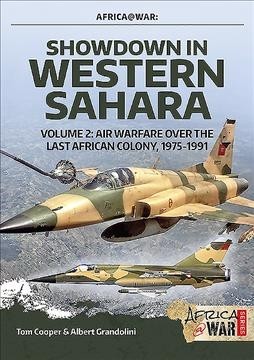| Showdown in Western Sahara: Air Warfare Over the Last African Colony: Volume 2 - 1975-1991 Contributor(s): Cooper, Tom (Author), Grandolini, Albert (Author), Fontanellaz, Adrien (Author) |
|
 |
ISBN: 1912866293 ISBN-13: 9781912866298 Publisher: Helion & Company OUR PRICE: $26.96 Product Type: Paperback - Other Formats Published: February 2020 |
| Additional Information |
| BISAC Categories: - History | Military - Wars & Conflicts (other) - History | Military - Aviation - History | Africa - West |
| Series: Africa@War |
| Physical Information: 0.3" H x 8.2" W x 11.6" (0.75 lbs) 88 pages |
| Themes: - Cultural Region - African - Cultural Region - West Africa - Chronological Period - 1950-1999 - Chronological Period - 1940's - Chronological Period - 1950's - Chronological Period - 1960's - Chronological Period - 1970's - Cultural Region - Spanish |
| Descriptions, Reviews, Etc. |
| Publisher Description: The former colony of Spanish Sahara saw frequent outbursts of tribal and ethnic rebellions while ruled by the colonial authorities in the late 19th and through the early 20th Century. Its vastness and distances essentially dictated the application of air power in response. While most of these events attracted next to no attention in English-language media, the large-scale operations of the Spanish colonial authorities of the late 1950s became notable at least for the final combat deployment of the famous Messerschmitt Bf.109. Following the Spanish withdrawal from Spanish Sahara in 1975, a major war erupted as Sahrawi nationalists - organized by the POLISARIO front - engaged in guerrilla warfare against Moroccan armed forces deployed to secure the northern part of the country, and Mauritanian forces deployed in the south. Characteristically for this period, POLISARIO's insurgency was often misinterpreted in the West as 'Soviet-influenced', although the rebels never adapted any related frameworks for their operations and tactics, such as those of Mao Zedong. On the contrary, while Algeria at least tolerated their bases on its soil, it was Libya that provided most of the support for the insurgency, eventually enabling it to defeat the Mauritanian military, slightly over a year later. Combined with POLISARIO's raids deep into Mauritania this prompted France to launch a limited military intervention in support. While tactically successful, this proved insufficient: Mauritania withdrew in 1979 after signing a peace treaty. Morocco continued fighting a series of bitter campaigns through 1979 and 1980, until rising costs and casualties prompted its government into developing an entirely new strategy. Construction of extensive earthen fortifications eventually slowed the war down to one of low intensity, only sporadically interrupted by insurgent attempts to achieve at least local successes. With both sides realizing that no solution through an armed conflict was possible, a cease-fire agreement was signed in 1991. However, this conflict still remains unresolved: it merely shifted to civilian resistance. Warfare in Western Sahara has in many ways become exemplary for modern-day counter-insurgency efforts in Africa and elsewhere. This conflict has been falsely declared as a part of some larger, external conflict - the Cold War; in regards of the concept of an insurgency applying motorized forces to deliver often spectacular 'hit-and-run' attacks; and in regards of a conventional military reacting with a combination of earth berms and air power. Illustrated by over 100 photograph as, a dozen maps and 18 colour profiles, Showdown in Western Sahara offers a fascinating study of the military aspects of this conflict, warfare strategies, tactics and experiences with different weapons systems. |
Contributor Bio(s): Cooper, Tom: - "Tom Cooper is an Austrian aerial warfare analyst and historian. Following a career in worldwide transportation business - during which he established a network of contacts in the Middle East and Africa - he moved into narrow-focus analysis and writing on small, little-known air forces and conflicts, about which he has collected extensive archives. This has resulted in specialisation in such Middle Eastern air forces as of those of Egypt, Iran, Iraq, and Syria, plus various African and Asian air forces. Except for authoring and co-authoring more than 30 books - including about a dozen of titles for Helion's @War series - and over 1000 articles, Cooper is a regular correspondent for multiple defence-related publications."Grandolini, Albert: - Military historian and aviation-journalist Albert Grandolini was born in Vietnam and gained an MA in history from Paris 1 Sorbonne University. His primary research focus is on contemporary conflicts in general and particularly on the military history in Asia and Africa. Having spent his childhood in South Vietnam, the Vietnam War has always been one of his main fields of research. He authored the book Fall of the Flying Dragon: South Vietnamese Air Force (1973-1975) two volumes on Vietnam's Easter Offensive of 1972 for Helion's Asia@War Series, and three volumes on Libyan Air Wars for Africa@War Series, and has written numerous articles for various British, French, and German magazines.Fontanellaz, Adrien: - Adrien Fontanellaz, from Switzerland, is a military history researcher and author. He developed a passion for military history at an early age and has progressively narrowed his studies to modern-day conflicts. He is a member of the Scientific Committee of the Pully-based Centre d'histoire et de prospective militaries (Military History and Prospectives Centre), and regularly contributes for the Revue Militaire Suisse and various French military history magazines. He is co-founder and a regular contributor to the French military history website L'autre cotè de la colline, and this is his seventh title for Helion's '@War' series. |